#Cultural and geographical proximity
Photo

Cultural and geographical proximity
Its closeness to Scythian decorative art may be explained by the ethnical, cultural and geographical proximity of these two peoples before they had come into contact with the Greeks, when cattle-raising was the economic basis of both peoples. The fate of this Thracian art is very clearly reflected in many objects in which the strong influence of Greek art is felt. Greek art was mainly instrumental in introducing plant motifs, so beloved of ancient Greek ornamentation; it was also instrumental in introducing whole subjects taken from ancient Greek mythology, in which human and animal forms overcome abstractness and come closer to nature. The silver plaques with scenes from the myth of Heracles, found in Panagyurish- te, are of special interest in this respect.
The art of building developed early among the Thracians. In the early periods it may be traced on the evidence of tomb architecture. Under the tumuli not only ordinary graves, but entire tombs are found, of great interest on account of their plan and structure. The cupola tombs are of particular interest in this respect; they are built of stone blocks, and later of bricks as well, covered with a false vault.The largest cupola tomb known so far was discovered in a tumulus near Me- zck (near Svilengrad), which is 14 m. high and has a diameter of 90 m. The tomb contains a passage 20.65m. long, 1.55m. wide and 2.40—2.60m. high, covered with a triangular vault.
Three chambers
This leads into three chambers, placed along an axis, of which the first two are square, 1.48 m. x 1.26 m. and 1.77 m.x 2.22 m.in size; the first is3.20 m. and the second 3.52 m. high, and both are covered like the passage. The third, end chamber, which is round with a diameter of 3.30 m. and a height of 4.30 m.is shaped like a bee-hive. This was the tomb chamber. Although this tomb was robbed in antiquity, a large number of bronze vessels were found here, together with the candelabrum described before, and some gold jewelry. The total length of the tomb is nearly 29.95 m holidays bulgaria. It dates back to the first half of the 4th century B. C.
The brick cupola that Kazanluk is far more modest in its dimensions. Its plan is much simpler, consisting of an open stone antechamber, a short passage and a bee-hive cupola tomb chamber built of bricks. The total length of the brick body is 5.80 m. But its wonderful murals distinguish this cupola tomb from the 13 other similar tombs known so far. They cover the entire inner surface of the passage and the vaulted chamber. Lower down the walls are covered with stucco work imitating a marble plinth, in the passage black orthostat between bands of white blocks, and in the vaulted chamber white orthostat between bands of black blocks.
0 notes
Photo

Cultural and geographical proximity
Its closeness to Scythian decorative art may be explained by the ethnical, cultural and geographical proximity of these two peoples before they had come into contact with the Greeks, when cattle-raising was the economic basis of both peoples. The fate of this Thracian art is very clearly reflected in many objects in which the strong influence of Greek art is felt. Greek art was mainly instrumental in introducing plant motifs, so beloved of ancient Greek ornamentation; it was also instrumental in introducing whole subjects taken from ancient Greek mythology, in which human and animal forms overcome abstractness and come closer to nature. The silver plaques with scenes from the myth of Heracles, found in Panagyurish- te, are of special interest in this respect.
The art of building developed early among the Thracians. In the early periods it may be traced on the evidence of tomb architecture. Under the tumuli not only ordinary graves, but entire tombs are found, of great interest on account of their plan and structure. The cupola tombs are of particular interest in this respect; they are built of stone blocks, and later of bricks as well, covered with a false vault.The largest cupola tomb known so far was discovered in a tumulus near Me- zck (near Svilengrad), which is 14 m. high and has a diameter of 90 m. The tomb contains a passage 20.65m. long, 1.55m. wide and 2.40—2.60m. high, covered with a triangular vault.
Three chambers
This leads into three chambers, placed along an axis, of which the first two are square, 1.48 m. x 1.26 m. and 1.77 m.x 2.22 m.in size; the first is3.20 m. and the second 3.52 m. high, and both are covered like the passage. The third, end chamber, which is round with a diameter of 3.30 m. and a height of 4.30 m.is shaped like a bee-hive. This was the tomb chamber. Although this tomb was robbed in antiquity, a large number of bronze vessels were found here, together with the candelabrum described before, and some gold jewelry. The total length of the tomb is nearly 29.95 m holidays bulgaria. It dates back to the first half of the 4th century B. C.
The brick cupola that Kazanluk is far more modest in its dimensions. Its plan is much simpler, consisting of an open stone antechamber, a short passage and a bee-hive cupola tomb chamber built of bricks. The total length of the brick body is 5.80 m. But its wonderful murals distinguish this cupola tomb from the 13 other similar tombs known so far. They cover the entire inner surface of the passage and the vaulted chamber. Lower down the walls are covered with stucco work imitating a marble plinth, in the passage black orthostat between bands of white blocks, and in the vaulted chamber white orthostat between bands of black blocks.
0 notes
Photo

Cultural and geographical proximity
Its closeness to Scythian decorative art may be explained by the ethnical, cultural and geographical proximity of these two peoples before they had come into contact with the Greeks, when cattle-raising was the economic basis of both peoples. The fate of this Thracian art is very clearly reflected in many objects in which the strong influence of Greek art is felt. Greek art was mainly instrumental in introducing plant motifs, so beloved of ancient Greek ornamentation; it was also instrumental in introducing whole subjects taken from ancient Greek mythology, in which human and animal forms overcome abstractness and come closer to nature. The silver plaques with scenes from the myth of Heracles, found in Panagyurish- te, are of special interest in this respect.
The art of building developed early among the Thracians. In the early periods it may be traced on the evidence of tomb architecture. Under the tumuli not only ordinary graves, but entire tombs are found, of great interest on account of their plan and structure. The cupola tombs are of particular interest in this respect; they are built of stone blocks, and later of bricks as well, covered with a false vault.The largest cupola tomb known so far was discovered in a tumulus near Me- zck (near Svilengrad), which is 14 m. high and has a diameter of 90 m. The tomb contains a passage 20.65m. long, 1.55m. wide and 2.40—2.60m. high, covered with a triangular vault.
Three chambers
This leads into three chambers, placed along an axis, of which the first two are square, 1.48 m. x 1.26 m. and 1.77 m.x 2.22 m.in size; the first is3.20 m. and the second 3.52 m. high, and both are covered like the passage. The third, end chamber, which is round with a diameter of 3.30 m. and a height of 4.30 m.is shaped like a bee-hive. This was the tomb chamber. Although this tomb was robbed in antiquity, a large number of bronze vessels were found here, together with the candelabrum described before, and some gold jewelry. The total length of the tomb is nearly 29.95 m holidays bulgaria. It dates back to the first half of the 4th century B. C.
The brick cupola that Kazanluk is far more modest in its dimensions. Its plan is much simpler, consisting of an open stone antechamber, a short passage and a bee-hive cupola tomb chamber built of bricks. The total length of the brick body is 5.80 m. But its wonderful murals distinguish this cupola tomb from the 13 other similar tombs known so far. They cover the entire inner surface of the passage and the vaulted chamber. Lower down the walls are covered with stucco work imitating a marble plinth, in the passage black orthostat between bands of white blocks, and in the vaulted chamber white orthostat between bands of black blocks.
0 notes
Photo

Cultural and geographical proximity
Its closeness to Scythian decorative art may be explained by the ethnical, cultural and geographical proximity of these two peoples before they had come into contact with the Greeks, when cattle-raising was the economic basis of both peoples. The fate of this Thracian art is very clearly reflected in many objects in which the strong influence of Greek art is felt. Greek art was mainly instrumental in introducing plant motifs, so beloved of ancient Greek ornamentation; it was also instrumental in introducing whole subjects taken from ancient Greek mythology, in which human and animal forms overcome abstractness and come closer to nature. The silver plaques with scenes from the myth of Heracles, found in Panagyurish- te, are of special interest in this respect.
The art of building developed early among the Thracians. In the early periods it may be traced on the evidence of tomb architecture. Under the tumuli not only ordinary graves, but entire tombs are found, of great interest on account of their plan and structure. The cupola tombs are of particular interest in this respect; they are built of stone blocks, and later of bricks as well, covered with a false vault.The largest cupola tomb known so far was discovered in a tumulus near Me- zck (near Svilengrad), which is 14 m. high and has a diameter of 90 m. The tomb contains a passage 20.65m. long, 1.55m. wide and 2.40—2.60m. high, covered with a triangular vault.
Three chambers
This leads into three chambers, placed along an axis, of which the first two are square, 1.48 m. x 1.26 m. and 1.77 m.x 2.22 m.in size; the first is3.20 m. and the second 3.52 m. high, and both are covered like the passage. The third, end chamber, which is round with a diameter of 3.30 m. and a height of 4.30 m.is shaped like a bee-hive. This was the tomb chamber. Although this tomb was robbed in antiquity, a large number of bronze vessels were found here, together with the candelabrum described before, and some gold jewelry. The total length of the tomb is nearly 29.95 m holidays bulgaria. It dates back to the first half of the 4th century B. C.
The brick cupola that Kazanluk is far more modest in its dimensions. Its plan is much simpler, consisting of an open stone antechamber, a short passage and a bee-hive cupola tomb chamber built of bricks. The total length of the brick body is 5.80 m. But its wonderful murals distinguish this cupola tomb from the 13 other similar tombs known so far. They cover the entire inner surface of the passage and the vaulted chamber. Lower down the walls are covered with stucco work imitating a marble plinth, in the passage black orthostat between bands of white blocks, and in the vaulted chamber white orthostat between bands of black blocks.
0 notes
Photo

Cultural and geographical proximity
Its closeness to Scythian decorative art may be explained by the ethnical, cultural and geographical proximity of these two peoples before they had come into contact with the Greeks, when cattle-raising was the economic basis of both peoples. The fate of this Thracian art is very clearly reflected in many objects in which the strong influence of Greek art is felt. Greek art was mainly instrumental in introducing plant motifs, so beloved of ancient Greek ornamentation; it was also instrumental in introducing whole subjects taken from ancient Greek mythology, in which human and animal forms overcome abstractness and come closer to nature. The silver plaques with scenes from the myth of Heracles, found in Panagyurish- te, are of special interest in this respect.
The art of building developed early among the Thracians. In the early periods it may be traced on the evidence of tomb architecture. Under the tumuli not only ordinary graves, but entire tombs are found, of great interest on account of their plan and structure. The cupola tombs are of particular interest in this respect; they are built of stone blocks, and later of bricks as well, covered with a false vault.The largest cupola tomb known so far was discovered in a tumulus near Me- zck (near Svilengrad), which is 14 m. high and has a diameter of 90 m. The tomb contains a passage 20.65m. long, 1.55m. wide and 2.40—2.60m. high, covered with a triangular vault.
Three chambers
This leads into three chambers, placed along an axis, of which the first two are square, 1.48 m. x 1.26 m. and 1.77 m.x 2.22 m.in size; the first is3.20 m. and the second 3.52 m. high, and both are covered like the passage. The third, end chamber, which is round with a diameter of 3.30 m. and a height of 4.30 m.is shaped like a bee-hive. This was the tomb chamber. Although this tomb was robbed in antiquity, a large number of bronze vessels were found here, together with the candelabrum described before, and some gold jewelry. The total length of the tomb is nearly 29.95 m holidays bulgaria. It dates back to the first half of the 4th century B. C.
The brick cupola that Kazanluk is far more modest in its dimensions. Its plan is much simpler, consisting of an open stone antechamber, a short passage and a bee-hive cupola tomb chamber built of bricks. The total length of the brick body is 5.80 m. But its wonderful murals distinguish this cupola tomb from the 13 other similar tombs known so far. They cover the entire inner surface of the passage and the vaulted chamber. Lower down the walls are covered with stucco work imitating a marble plinth, in the passage black orthostat between bands of white blocks, and in the vaulted chamber white orthostat between bands of black blocks.
0 notes
Photo

Cultural and geographical proximity
Its closeness to Scythian decorative art may be explained by the ethnical, cultural and geographical proximity of these two peoples before they had come into contact with the Greeks, when cattle-raising was the economic basis of both peoples. The fate of this Thracian art is very clearly reflected in many objects in which the strong influence of Greek art is felt. Greek art was mainly instrumental in introducing plant motifs, so beloved of ancient Greek ornamentation; it was also instrumental in introducing whole subjects taken from ancient Greek mythology, in which human and animal forms overcome abstractness and come closer to nature. The silver plaques with scenes from the myth of Heracles, found in Panagyurish- te, are of special interest in this respect.
The art of building developed early among the Thracians. In the early periods it may be traced on the evidence of tomb architecture. Under the tumuli not only ordinary graves, but entire tombs are found, of great interest on account of their plan and structure. The cupola tombs are of particular interest in this respect; they are built of stone blocks, and later of bricks as well, covered with a false vault.The largest cupola tomb known so far was discovered in a tumulus near Me- zck (near Svilengrad), which is 14 m. high and has a diameter of 90 m. The tomb contains a passage 20.65m. long, 1.55m. wide and 2.40—2.60m. high, covered with a triangular vault.
Three chambers
This leads into three chambers, placed along an axis, of which the first two are square, 1.48 m. x 1.26 m. and 1.77 m.x 2.22 m.in size; the first is3.20 m. and the second 3.52 m. high, and both are covered like the passage. The third, end chamber, which is round with a diameter of 3.30 m. and a height of 4.30 m.is shaped like a bee-hive. This was the tomb chamber. Although this tomb was robbed in antiquity, a large number of bronze vessels were found here, together with the candelabrum described before, and some gold jewelry. The total length of the tomb is nearly 29.95 m holidays bulgaria. It dates back to the first half of the 4th century B. C.
The brick cupola that Kazanluk is far more modest in its dimensions. Its plan is much simpler, consisting of an open stone antechamber, a short passage and a bee-hive cupola tomb chamber built of bricks. The total length of the brick body is 5.80 m. But its wonderful murals distinguish this cupola tomb from the 13 other similar tombs known so far. They cover the entire inner surface of the passage and the vaulted chamber. Lower down the walls are covered with stucco work imitating a marble plinth, in the passage black orthostat between bands of white blocks, and in the vaulted chamber white orthostat between bands of black blocks.
0 notes
Photo

Cultural and geographical proximity
Its closeness to Scythian decorative art may be explained by the ethnical, cultural and geographical proximity of these two peoples before they had come into contact with the Greeks, when cattle-raising was the economic basis of both peoples. The fate of this Thracian art is very clearly reflected in many objects in which the strong influence of Greek art is felt. Greek art was mainly instrumental in introducing plant motifs, so beloved of ancient Greek ornamentation; it was also instrumental in introducing whole subjects taken from ancient Greek mythology, in which human and animal forms overcome abstractness and come closer to nature. The silver plaques with scenes from the myth of Heracles, found in Panagyurish- te, are of special interest in this respect.
The art of building developed early among the Thracians. In the early periods it may be traced on the evidence of tomb architecture. Under the tumuli not only ordinary graves, but entire tombs are found, of great interest on account of their plan and structure. The cupola tombs are of particular interest in this respect; they are built of stone blocks, and later of bricks as well, covered with a false vault.The largest cupola tomb known so far was discovered in a tumulus near Me- zck (near Svilengrad), which is 14 m. high and has a diameter of 90 m. The tomb contains a passage 20.65m. long, 1.55m. wide and 2.40—2.60m. high, covered with a triangular vault.
Three chambers
This leads into three chambers, placed along an axis, of which the first two are square, 1.48 m. x 1.26 m. and 1.77 m.x 2.22 m.in size; the first is3.20 m. and the second 3.52 m. high, and both are covered like the passage. The third, end chamber, which is round with a diameter of 3.30 m. and a height of 4.30 m.is shaped like a bee-hive. This was the tomb chamber. Although this tomb was robbed in antiquity, a large number of bronze vessels were found here, together with the candelabrum described before, and some gold jewelry. The total length of the tomb is nearly 29.95 m holidays bulgaria. It dates back to the first half of the 4th century B. C.
The brick cupola that Kazanluk is far more modest in its dimensions. Its plan is much simpler, consisting of an open stone antechamber, a short passage and a bee-hive cupola tomb chamber built of bricks. The total length of the brick body is 5.80 m. But its wonderful murals distinguish this cupola tomb from the 13 other similar tombs known so far. They cover the entire inner surface of the passage and the vaulted chamber. Lower down the walls are covered with stucco work imitating a marble plinth, in the passage black orthostat between bands of white blocks, and in the vaulted chamber white orthostat between bands of black blocks.
0 notes
Photo

Cultural and geographical proximity
Its closeness to Scythian decorative art may be explained by the ethnical, cultural and geographical proximity of these two peoples before they had come into contact with the Greeks, when cattle-raising was the economic basis of both peoples. The fate of this Thracian art is very clearly reflected in many objects in which the strong influence of Greek art is felt. Greek art was mainly instrumental in introducing plant motifs, so beloved of ancient Greek ornamentation; it was also instrumental in introducing whole subjects taken from ancient Greek mythology, in which human and animal forms overcome abstractness and come closer to nature. The silver plaques with scenes from the myth of Heracles, found in Panagyurish- te, are of special interest in this respect.
The art of building developed early among the Thracians. In the early periods it may be traced on the evidence of tomb architecture. Under the tumuli not only ordinary graves, but entire tombs are found, of great interest on account of their plan and structure. The cupola tombs are of particular interest in this respect; they are built of stone blocks, and later of bricks as well, covered with a false vault.The largest cupola tomb known so far was discovered in a tumulus near Me- zck (near Svilengrad), which is 14 m. high and has a diameter of 90 m. The tomb contains a passage 20.65m. long, 1.55m. wide and 2.40—2.60m. high, covered with a triangular vault.
Three chambers
This leads into three chambers, placed along an axis, of which the first two are square, 1.48 m. x 1.26 m. and 1.77 m.x 2.22 m.in size; the first is3.20 m. and the second 3.52 m. high, and both are covered like the passage. The third, end chamber, which is round with a diameter of 3.30 m. and a height of 4.30 m.is shaped like a bee-hive. This was the tomb chamber. Although this tomb was robbed in antiquity, a large number of bronze vessels were found here, together with the candelabrum described before, and some gold jewelry. The total length of the tomb is nearly 29.95 m holidays bulgaria. It dates back to the first half of the 4th century B. C.
The brick cupola that Kazanluk is far more modest in its dimensions. Its plan is much simpler, consisting of an open stone antechamber, a short passage and a bee-hive cupola tomb chamber built of bricks. The total length of the brick body is 5.80 m. But its wonderful murals distinguish this cupola tomb from the 13 other similar tombs known so far. They cover the entire inner surface of the passage and the vaulted chamber. Lower down the walls are covered with stucco work imitating a marble plinth, in the passage black orthostat between bands of white blocks, and in the vaulted chamber white orthostat between bands of black blocks.
0 notes
Text
New Post has been published on
Cultural and geographical proximity
Its closeness to Scythian decorative art may be explained by the ethnical, cultural and geographical proximity of these two peoples before they had come into contact with the Greeks, when cattle-raising was the economic basis of both peoples. The fate of this Thracian art is very clearly reflected in many objects in which the strong influence of Greek art is felt. Greek art was mainly instrumental in introducing plant motifs, so beloved of ancient Greek ornamentation; it was also instrumental in introducing whole subjects taken from ancient Greek mythology, in which human and animal forms overcome abstractness and come closer to nature. The silver plaques with scenes from the myth of Heracles, found in Panagyurish- te, are of special interest in this respect.
The art of building developed early among the Thracians. In the early periods it may be traced on the evidence of tomb architecture. Under the tumuli not only ordinary graves, but entire tombs are found, of great interest on account of their plan and structure. The cupola tombs are of particular interest in this respect; they are built of stone blocks, and later of bricks as well, covered with a false vault.The largest cupola tomb known so far was discovered in a tumulus near Me- zck (near Svilengrad), which is 14 m. high and has a diameter of 90 m. The tomb contains a passage 20.65m. long, 1.55m. wide and 2.40—2.60m. high, covered with a triangular vault.
Three chambers
This leads into three chambers, placed along an axis, of which the first two are square, 1.48 m. x 1.26 m. and 1.77 m.x 2.22 m.in size; the first is3.20 m. and the second 3.52 m. high, and both are covered like the passage. The third, end chamber, which is round with a diameter of 3.30 m. and a height of 4.30 m.is shaped like a bee-hive. This was the tomb chamber. Although this tomb was robbed in antiquity, a large number of bronze vessels were found here, together with the candelabrum described before, and some gold jewelry. The total length of the tomb is nearly 29.95 m holidays bulgaria. It dates back to the first half of the 4th century B. C.
The brick cupola that Kazanluk is far more modest in its dimensions. Its plan is much simpler, consisting of an open stone antechamber, a short passage and a bee-hive cupola tomb chamber built of bricks. The total length of the brick body is 5.80 m. But its wonderful murals distinguish this cupola tomb from the 13 other similar tombs known so far. They cover the entire inner surface of the passage and the vaulted chamber. Lower down the walls are covered with stucco work imitating a marble plinth, in the passage black orthostat between bands of white blocks, and in the vaulted chamber white orthostat between bands of black blocks.
0 notes
Photo

Cultural and geographical proximity
Its closeness to Scythian decorative art may be explained by the ethnical, cultural and geographical proximity of these two peoples before they had come into contact with the Greeks, when cattle-raising was the economic basis of both peoples. The fate of this Thracian art is very clearly reflected in many objects in which the strong influence of Greek art is felt. Greek art was mainly instrumental in introducing plant motifs, so beloved of ancient Greek ornamentation; it was also instrumental in introducing whole subjects taken from ancient Greek mythology, in which human and animal forms overcome abstractness and come closer to nature. The silver plaques with scenes from the myth of Heracles, found in Panagyurish- te, are of special interest in this respect.
The art of building developed early among the Thracians. In the early periods it may be traced on the evidence of tomb architecture. Under the tumuli not only ordinary graves, but entire tombs are found, of great interest on account of their plan and structure. The cupola tombs are of particular interest in this respect; they are built of stone blocks, and later of bricks as well, covered with a false vault.The largest cupola tomb known so far was discovered in a tumulus near Me- zck (near Svilengrad), which is 14 m. high and has a diameter of 90 m. The tomb contains a passage 20.65m. long, 1.55m. wide and 2.40—2.60m. high, covered with a triangular vault.
Three chambers
This leads into three chambers, placed along an axis, of which the first two are square, 1.48 m. x 1.26 m. and 1.77 m.x 2.22 m.in size; the first is3.20 m. and the second 3.52 m. high, and both are covered like the passage. The third, end chamber, which is round with a diameter of 3.30 m. and a height of 4.30 m.is shaped like a bee-hive. This was the tomb chamber. Although this tomb was robbed in antiquity, a large number of bronze vessels were found here, together with the candelabrum described before, and some gold jewelry. The total length of the tomb is nearly 29.95 m holidays bulgaria. It dates back to the first half of the 4th century B. C.
The brick cupola that Kazanluk is far more modest in its dimensions. Its plan is much simpler, consisting of an open stone antechamber, a short passage and a bee-hive cupola tomb chamber built of bricks. The total length of the brick body is 5.80 m. But its wonderful murals distinguish this cupola tomb from the 13 other similar tombs known so far. They cover the entire inner surface of the passage and the vaulted chamber. Lower down the walls are covered with stucco work imitating a marble plinth, in the passage black orthostat between bands of white blocks, and in the vaulted chamber white orthostat between bands of black blocks.
0 notes
Photo

Cultural and geographical proximity
Its closeness to Scythian decorative art may be explained by the ethnical, cultural and geographical proximity of these two peoples before they had come into contact with the Greeks, when cattle-raising was the economic basis of both peoples. The fate of this Thracian art is very clearly reflected in many objects in which the strong influence of Greek art is felt. Greek art was mainly instrumental in introducing plant motifs, so beloved of ancient Greek ornamentation; it was also instrumental in introducing whole subjects taken from ancient Greek mythology, in which human and animal forms overcome abstractness and come closer to nature. The silver plaques with scenes from the myth of Heracles, found in Panagyurish- te, are of special interest in this respect.
The art of building developed early among the Thracians. In the early periods it may be traced on the evidence of tomb architecture. Under the tumuli not only ordinary graves, but entire tombs are found, of great interest on account of their plan and structure. The cupola tombs are of particular interest in this respect; they are built of stone blocks, and later of bricks as well, covered with a false vault.The largest cupola tomb known so far was discovered in a tumulus near Me- zck (near Svilengrad), which is 14 m. high and has a diameter of 90 m. The tomb contains a passage 20.65m. long, 1.55m. wide and 2.40—2.60m. high, covered with a triangular vault.
Three chambers
This leads into three chambers, placed along an axis, of which the first two are square, 1.48 m. x 1.26 m. and 1.77 m.x 2.22 m.in size; the first is3.20 m. and the second 3.52 m. high, and both are covered like the passage. The third, end chamber, which is round with a diameter of 3.30 m. and a height of 4.30 m.is shaped like a bee-hive. This was the tomb chamber. Although this tomb was robbed in antiquity, a large number of bronze vessels were found here, together with the candelabrum described before, and some gold jewelry. The total length of the tomb is nearly 29.95 m holidays bulgaria. It dates back to the first half of the 4th century B. C.
The brick cupola that Kazanluk is far more modest in its dimensions. Its plan is much simpler, consisting of an open stone antechamber, a short passage and a bee-hive cupola tomb chamber built of bricks. The total length of the brick body is 5.80 m. But its wonderful murals distinguish this cupola tomb from the 13 other similar tombs known so far. They cover the entire inner surface of the passage and the vaulted chamber. Lower down the walls are covered with stucco work imitating a marble plinth, in the passage black orthostat between bands of white blocks, and in the vaulted chamber white orthostat between bands of black blocks.
0 notes
Photo

Cultural and geographical proximity
Its closeness to Scythian decorative art may be explained by the ethnical, cultural and geographical proximity of these two peoples before they had come into contact with the Greeks, when cattle-raising was the economic basis of both peoples. The fate of this Thracian art is very clearly reflected in many objects in which the strong influence of Greek art is felt. Greek art was mainly instrumental in introducing plant motifs, so beloved of ancient Greek ornamentation; it was also instrumental in introducing whole subjects taken from ancient Greek mythology, in which human and animal forms overcome abstractness and come closer to nature. The silver plaques with scenes from the myth of Heracles, found in Panagyurish- te, are of special interest in this respect.
The art of building developed early among the Thracians. In the early periods it may be traced on the evidence of tomb architecture. Under the tumuli not only ordinary graves, but entire tombs are found, of great interest on account of their plan and structure. The cupola tombs are of particular interest in this respect; they are built of stone blocks, and later of bricks as well, covered with a false vault.The largest cupola tomb known so far was discovered in a tumulus near Me- zck (near Svilengrad), which is 14 m. high and has a diameter of 90 m. The tomb contains a passage 20.65m. long, 1.55m. wide and 2.40—2.60m. high, covered with a triangular vault.
Three chambers
This leads into three chambers, placed along an axis, of which the first two are square, 1.48 m. x 1.26 m. and 1.77 m.x 2.22 m.in size; the first is3.20 m. and the second 3.52 m. high, and both are covered like the passage. The third, end chamber, which is round with a diameter of 3.30 m. and a height of 4.30 m.is shaped like a bee-hive. This was the tomb chamber. Although this tomb was robbed in antiquity, a large number of bronze vessels were found here, together with the candelabrum described before, and some gold jewelry. The total length of the tomb is nearly 29.95 m holidays bulgaria. It dates back to the first half of the 4th century B. C.
The brick cupola that Kazanluk is far more modest in its dimensions. Its plan is much simpler, consisting of an open stone antechamber, a short passage and a bee-hive cupola tomb chamber built of bricks. The total length of the brick body is 5.80 m. But its wonderful murals distinguish this cupola tomb from the 13 other similar tombs known so far. They cover the entire inner surface of the passage and the vaulted chamber. Lower down the walls are covered with stucco work imitating a marble plinth, in the passage black orthostat between bands of white blocks, and in the vaulted chamber white orthostat between bands of black blocks.
0 notes
Photo

Cultural and geographical proximity
Its closeness to Scythian decorative art may be explained by the ethnical, cultural and geographical proximity of these two peoples before they had come into contact with the Greeks, when cattle-raising was the economic basis of both peoples. The fate of this Thracian art is very clearly reflected in many objects in which the strong influence of Greek art is felt. Greek art was mainly instrumental in introducing plant motifs, so beloved of ancient Greek ornamentation; it was also instrumental in introducing whole subjects taken from ancient Greek mythology, in which human and animal forms overcome abstractness and come closer to nature. The silver plaques with scenes from the myth of Heracles, found in Panagyurish- te, are of special interest in this respect.
The art of building developed early among the Thracians. In the early periods it may be traced on the evidence of tomb architecture. Under the tumuli not only ordinary graves, but entire tombs are found, of great interest on account of their plan and structure. The cupola tombs are of particular interest in this respect; they are built of stone blocks, and later of bricks as well, covered with a false vault.The largest cupola tomb known so far was discovered in a tumulus near Me- zck (near Svilengrad), which is 14 m. high and has a diameter of 90 m. The tomb contains a passage 20.65m. long, 1.55m. wide and 2.40—2.60m. high, covered with a triangular vault.
Three chambers
This leads into three chambers, placed along an axis, of which the first two are square, 1.48 m. x 1.26 m. and 1.77 m.x 2.22 m.in size; the first is3.20 m. and the second 3.52 m. high, and both are covered like the passage. The third, end chamber, which is round with a diameter of 3.30 m. and a height of 4.30 m.is shaped like a bee-hive. This was the tomb chamber. Although this tomb was robbed in antiquity, a large number of bronze vessels were found here, together with the candelabrum described before, and some gold jewelry. The total length of the tomb is nearly 29.95 m holidays bulgaria. It dates back to the first half of the 4th century B. C.
The brick cupola that Kazanluk is far more modest in its dimensions. Its plan is much simpler, consisting of an open stone antechamber, a short passage and a bee-hive cupola tomb chamber built of bricks. The total length of the brick body is 5.80 m. But its wonderful murals distinguish this cupola tomb from the 13 other similar tombs known so far. They cover the entire inner surface of the passage and the vaulted chamber. Lower down the walls are covered with stucco work imitating a marble plinth, in the passage black orthostat between bands of white blocks, and in the vaulted chamber white orthostat between bands of black blocks.
0 notes
Photo
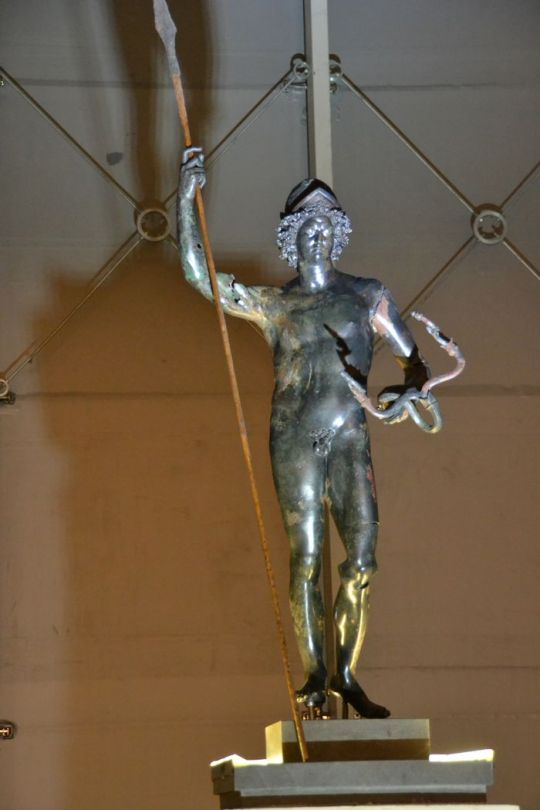
Cultural and geographical proximity
Its closeness to Scythian decorative art may be explained by the ethnical, cultural and geographical proximity of these two peoples before they had come into contact with the Greeks, when cattle-raising was the economic basis of both peoples. The fate of this Thracian art is very clearly reflected in many objects in which the strong influence of Greek art is felt. Greek art was mainly instrumental in introducing plant motifs, so beloved of ancient Greek ornamentation; it was also instrumental in introducing whole subjects taken from ancient Greek mythology, in which human and animal forms overcome abstractness and come closer to nature. The silver plaques with scenes from the myth of Heracles, found in Panagyurish- te, are of special interest in this respect.
The art of building developed early among the Thracians. In the early periods it may be traced on the evidence of tomb architecture. Under the tumuli not only ordinary graves, but entire tombs are found, of great interest on account of their plan and structure. The cupola tombs are of particular interest in this respect; they are built of stone blocks, and later of bricks as well, covered with a false vault.The largest cupola tomb known so far was discovered in a tumulus near Me- zck (near Svilengrad), which is 14 m. high and has a diameter of 90 m. The tomb contains a passage 20.65m. long, 1.55m. wide and 2.40—2.60m. high, covered with a triangular vault.
Three chambers
This leads into three chambers, placed along an axis, of which the first two are square, 1.48 m. x 1.26 m. and 1.77 m.x 2.22 m.in size; the first is3.20 m. and the second 3.52 m. high, and both are covered like the passage. The third, end chamber, which is round with a diameter of 3.30 m. and a height of 4.30 m.is shaped like a bee-hive. This was the tomb chamber. Although this tomb was robbed in antiquity, a large number of bronze vessels were found here, together with the candelabrum described before, and some gold jewelry. The total length of the tomb is nearly 29.95 m holidays bulgaria. It dates back to the first half of the 4th century B. C.
The brick cupola that Kazanluk is far more modest in its dimensions. Its plan is much simpler, consisting of an open stone antechamber, a short passage and a bee-hive cupola tomb chamber built of bricks. The total length of the brick body is 5.80 m. But its wonderful murals distinguish this cupola tomb from the 13 other similar tombs known so far. They cover the entire inner surface of the passage and the vaulted chamber. Lower down the walls are covered with stucco work imitating a marble plinth, in the passage black orthostat between bands of white blocks, and in the vaulted chamber white orthostat between bands of black blocks.
0 notes
Text
I love preordering books because I forget about them until they arrive and once they arrive, I'm all at once surprised, charmed by my own forethought, and as excited as when I first noticed them enough to preorder them.
(Today's title: Beauty Matters: Modern Japanese Literature and the Question of Aesthetics (1890-1930) by Anri Yasuda, the chapters of which include (i) Natsume Soseki's Quest for "A Feeling of Beauty," (ii) Mori Ogai and the "Inner Flame" of Beauty, and (iii) Akutagawa Ryunosuke's Literary Anxietieis and the "Power to Remake.")
#bsd#bungou stray dogs#i should maybe just. have a modern japanese lit tag that i use regularly instead.#but (for now) i'm reading only modern japanese lit & history titles related to or for their proximity to bsd and the bsd relevant histories#so it's as much part of my bsd fandom engagement as anything bsd i post#which isn't to say they're not also separate works and i'm not also very invested in the irl people and their lives separately from bsd too#but focusing on the bsd authors has kept me from becoming overwhelmed and my affection for them began with bsd#and kafka asagiri's dialogue with their legacies#so while I don't tag bsd when i'm talking about only the authors or only the authors' works#there's sometimes little to no distinction for me between the literary critique (bsd) and whatever literary critique (academic) i'm reading#this isn't to say i conflate the characters with the people#or vice versa#but rather to say that i am also engaging in dialogues with the authors that are part of other more abstract conversations#at a conference hosted by asagiri and harukawa#convos which I am dangerously close to escalating by writing my own autobiographical fiction novel#framed within a metaconversation between the fictional author and her impressions of the dead authors#as filtered through time + geographical and cultural distance + translation + the inherently muddled natures of truth and confession#namely because i'm frequently haunted by akutagawa with whom I avoid speaking but to whom I can't bring myself to let go#despite the inherent violence in my presuming to know any amount of him at all#and sometimes because of it
5 notes
·
View notes
Text
What does life in North Korea look like outside of Pyongyang? 🇰🇵
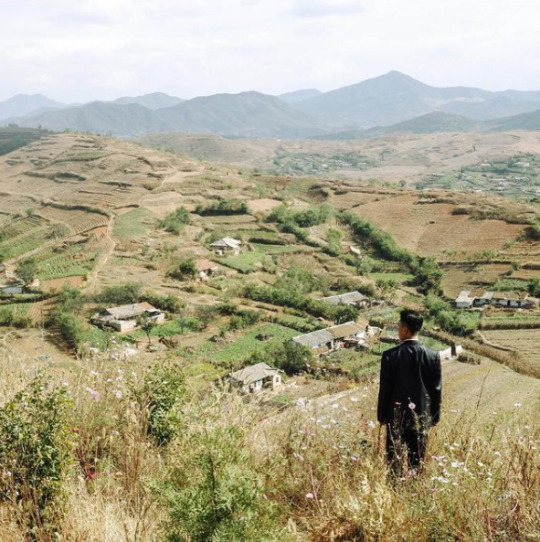
Hey, I'm back again with a very scary "tankie" post that asks you to think of North Koreans as people, and to consider their country not as a cartoonish dystopia, but as a nation that, like any other place on earth, has culture, traditions, and history.
Below is a collection of pictures from various cities and places in North Korea, along with a brief dive into some of the historical events that informs life in the so-called "hermit kingdom."
Warning: very long post
Kaesong, the historic city
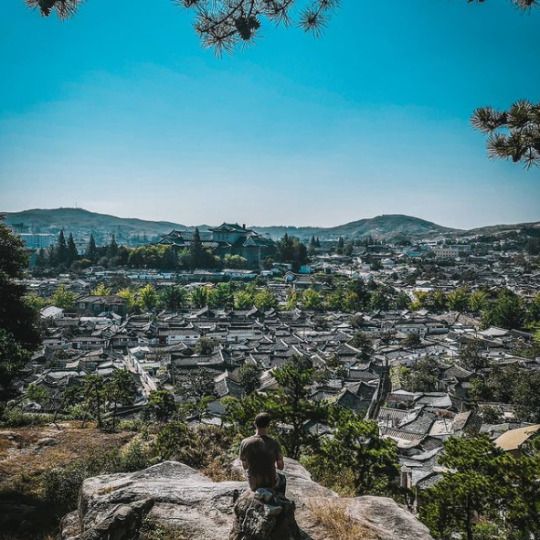
Beginning this post with Kaesong, one of the oldest cities in Korea. It's also one of the few major cities in the DPRK (i.e. "North Korea") that was not completely destroyed during the Korean war.
Every single city you'll see from this point on were victims of intense aerial bombardments from the U.S. and its allies, and had to be either partially or completely rebuilt after the war.
From 1951 to 1953, during what has now become known as the "forgotten war" in the West, the U.S. dropped 635,000 tons of bombs over Korea — most of it in the North, and on civilian population centers. An additional 32,000 tons of napalm was also deployed, engulfing whole cities in fire and inflicting people with horrific burns:
For such a simple thing to make, napalm had horrific human consequences. A bit of liquid fire, a sort of jellied gasoline, napalm clung to human skin on contact and melted off the flesh. Witnesses to napalm's impact described eyelids so burned they could not be shut and flesh that looked like "swollen, raw meat." - PBS
Ever wondered why North Koreans seem to hate the U.S so much? Well...
Keep in mind that only a few years prior to this, the U.S. had, as the first and only country in the world, used the atomic bomb as a weapon of war. Consider, too, the proximity between Japan and Korea — both geographically and as an "Other" in the Western imagination.
As the war dragged on, and it became clear the U.S. and its allies would not "win" in any conventional sense, the fear that the U.S. would resort to nuclear weapons again loomed large, adding another frightening dimension to the war that can probably go a long way in explaining the DPRK's later obsession with acquiring their own nuclear bomb.
But even without the use of nuclear weapons, the indiscriminate attack on civilians, particularly from U.S. saturation bombings, was still horrific:
"The number of Korean dead, injured or missing by war’s end approached three million, ten percent of the overall population. The majority of those killed were in the North, which had half of the population of the South; although the DPRK does not have official figures, possibly twelve to fifteen percent of the population was killed in the war, a figure close to or surpassing the proportion of Soviet citizens killed in World War II" - Charles K. Armstrong
On top of the loss of life, there's also the material damage. By the end of the war, the U.S. Air Force had, by its own estimations, destroyed somewhere around 85% of all buildings in the DPRK, leaving most cities in complete ruin. There are even stories of U.S. bombers dropping their loads into the ocean because they couldn't find any visible targets to bomb.
What you'll see below of Kaesong, then, provides both a rare glimpse of what life in North Korea looked like before the war, and a reminder of what was destroyed.

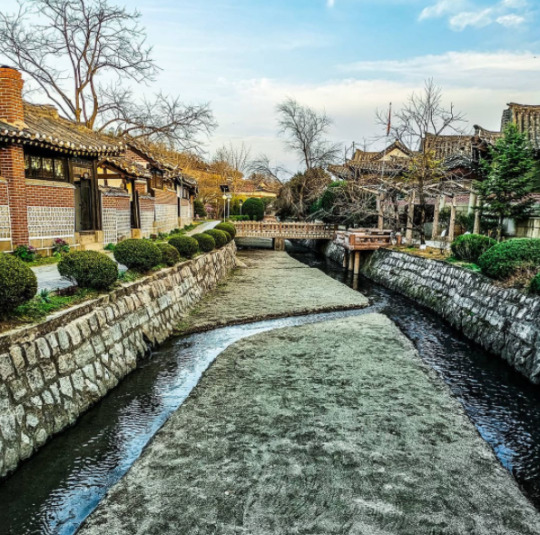

Kaesong's main street, pictured below.
Due the stifling sanctions imposed on the DPRK—which has, in various forms and intensities, been in effect since the 1950s—car ownership is still low throughout the country, with most people getting around either by walking or biking, or by bus or train for longer distances.
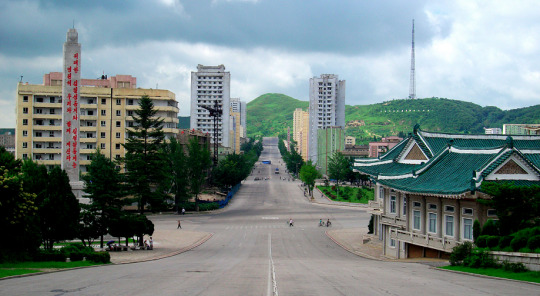
Kaesong, which is regarded as an educational center, is also notable for its many Koryŏ-era monuments. A group of twelve such sites were granted UNESCO world heritage status in 2013.
Included is the Hyonjongnung Royal Tomb, a 14th-century mausoleum located just outside the city of Kaesong.
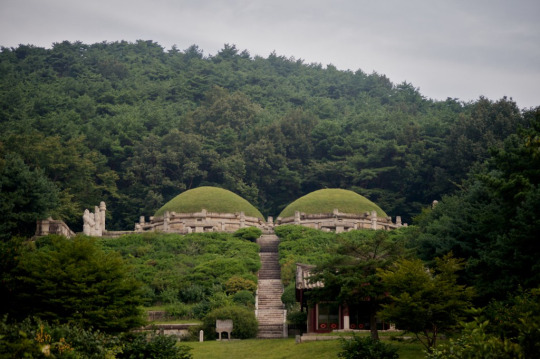
One of the statues guarding the tomb.
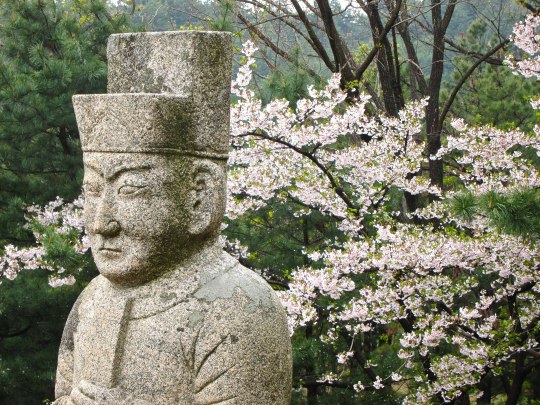
Before moving on the other cities, I also wanted to showcase one more of the DPRK's historical sites: Pohyonsa, a thousand-year-old Buddhist temple complex located in the Myohyang Mountains.

Like many of DPRK's historic sites, the temple complex suffered extensive damage during the Korean war, with the U.S. led bombings destroying over half of its 24 pre-war buildings.
The complex has since been restored and is in use today both as a residence for Buddhist monks, and as a historic site open to visitors.


Hamhung, the second largest city in the DPRK.
A coastal city located in the South Hamgyŏng Province. It has long served as a major industrial hub in the DPRK, and has one of the largest and busiest ports in the country.
Hamhung, like most of the coastal cities in the DPRK, was hit particularly hard during the war. Through relentless aerial bombardments, the US and its allies destroyed somewhere around 80-90% percent of all buildings, roads, and other infrastructure in the city.
Now, more than seventy years later, unexploded bombs, mortars and pieces of live ammunition are still being unearthed by the thousands in the area. As recently as 2016, one of North Korea's bomb squads—there's one in every province, faced with the same cleanup task—retrieved 370 unexploded mortar rounds... from an elementary school playground.
Experts in the DPRK estimate it will probably take over a hundred years to clean up all the unexploded ordnance—and that's just in and around Hamhung.
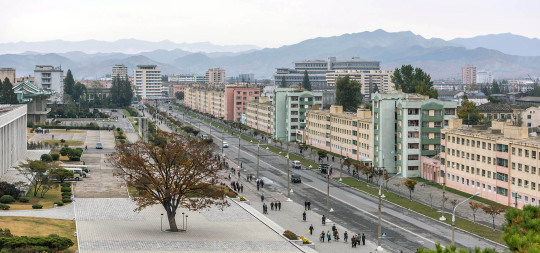

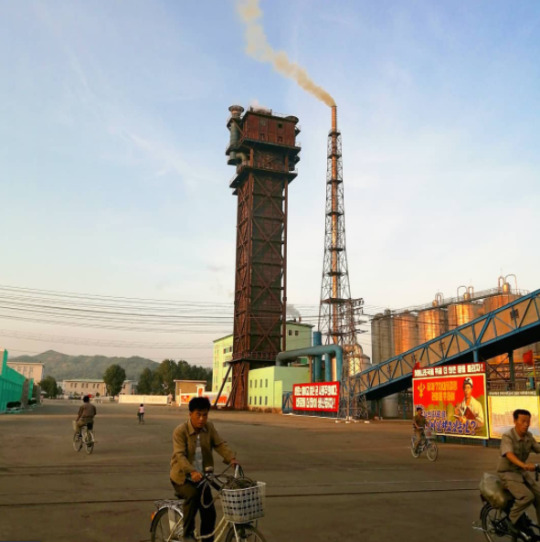
Hamhung's fertilizer plant, the biggest in North Korea.
When the war broke out, Hamhung was home to the largest nitrogen fertilizer plant in Asia. Since its product could be used in the creation of explosives, the existence of the plant is considered to have made Hamhung a target for U.S. aggression (though it's worth repeating that the U.S. carried out saturation bombings of most population centers in the country, irrespective of any so-called 'military value').
The plant was immediately rebuilt after the war, and—beyond its practical use—serves now as a monument of resistance to U.S. imperialism, and as a functional and symbolic site of self-reliance.
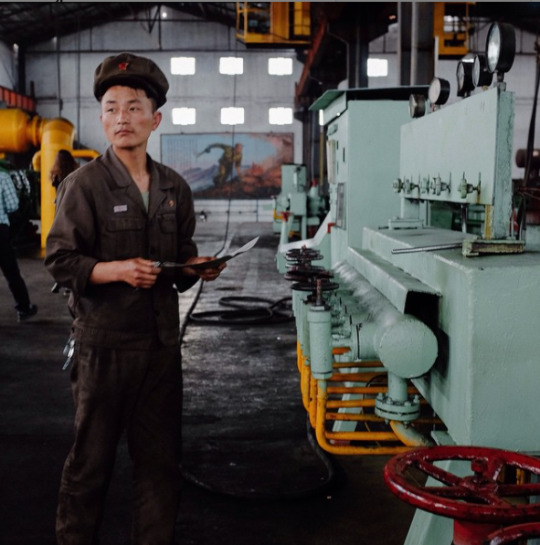
Chongjin, the third largest city in the DPRK.
Another coastal city and industrial hub. It underwent a massive development prior to the Korean war, housing around 300,000 people by the time the war broke out.
By 1953, the U.S. had destroyed most of Chongjin's industry, bombed its harbors, and killed one third of the population.
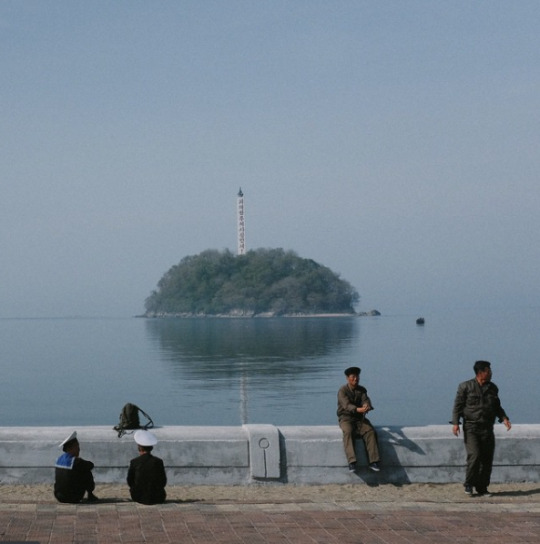
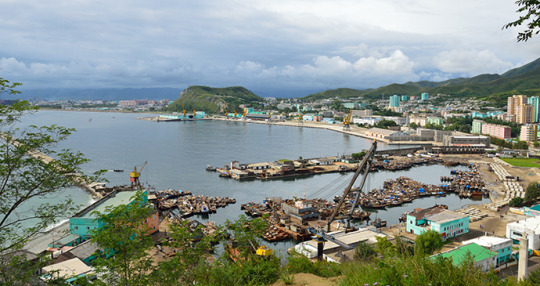

Wonsan, a rebuilt seaside city.
The city of Wonsan is a vital link between the DPRK's east and west coasts, and acts today as both a popular holiday destination for North Koreans, and as a central location for the country's growing tourism industry.
Considered a strategically important location during the war, Wonsan is notable for having endured one of the longest naval blockades in modern history, lasting a total of 861 days.
By the end of the war, the U.S. estimated that they had destroyed around 80% of the city.
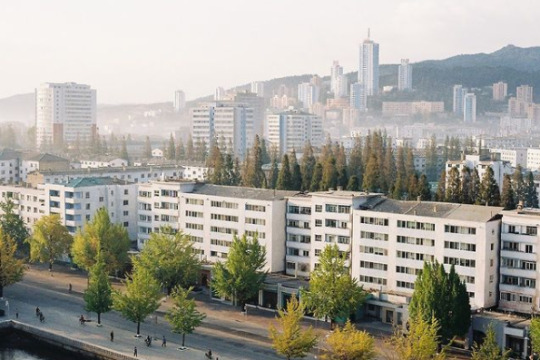

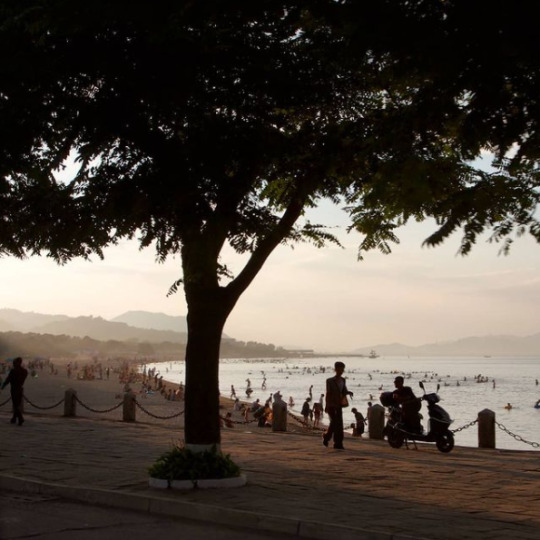

Masikryong Ski Resort, located close to Wonsan. It opened to the public in 2014 and is the first, I believe, that was built with foreign tourists in mind.
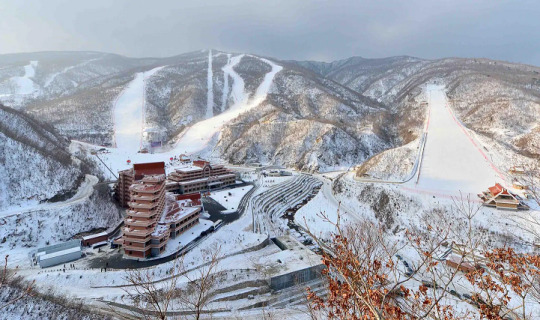
Sariwon, another rebuilt city
One of the worst hit cities during the Korean War, with an estimated destruction level of 95%.
I've written about its Wikipedia page here before, which used to mockingly describe its 'folk customs street'—a project built to preserve old Korean traditions and customs—as an "inaccurate romanticized recreation of an ancient Korean street."
No mention, of course, of the destruction caused by the US-led aerial bombings, or any historical context at all that could possibly even hint at why the preservation of old traditions might be particularly important for the city.
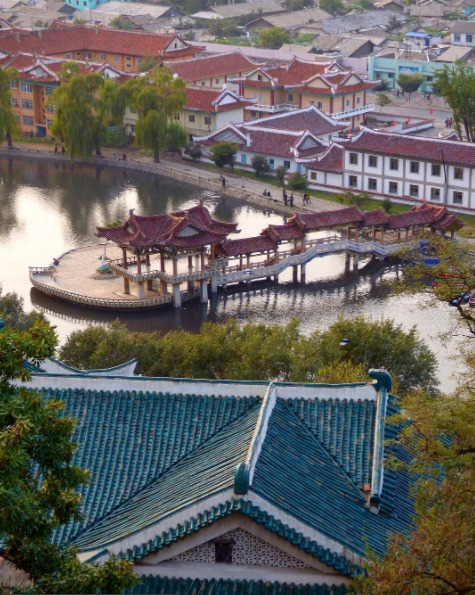

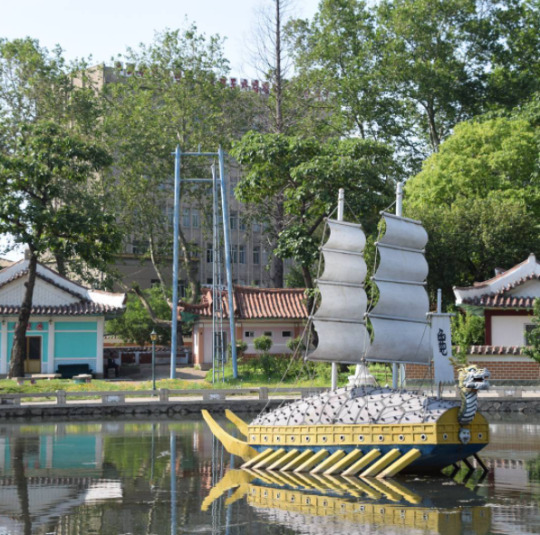
Life outside of the towns and cities
In the rural parts of the DPRK, life primarily revolves around agriculture. As the sanctions they're under make it difficult to acquire fuel, farming in the DPRK relies heavily on manual labour, which again, to avoid food shortages, requires that a large portion of the labour force resides in the countryside.
Unlike what many may think, the reliance on manual labour in farming is a relatively "new" development. Up until the crisis of the 1990s, the DPRK was a highly industrialized nation, with a modernized agricultural system and a high urbanization rate. But, as the access to cheap fuel from the USSR and China disappeared, and the sanctions placed upon them by Western nations heavily restricted their ability to import fuel from other sources, having a fuel-dependent agricultural industry became a recipe for disaster, and required an immediate and brutal restructuring.
For a more detailed breakdown of what lead to the crisis in the 90s, and how it reshaped the DPRKs approach to agriculture, check out this article by Zhun Xu.

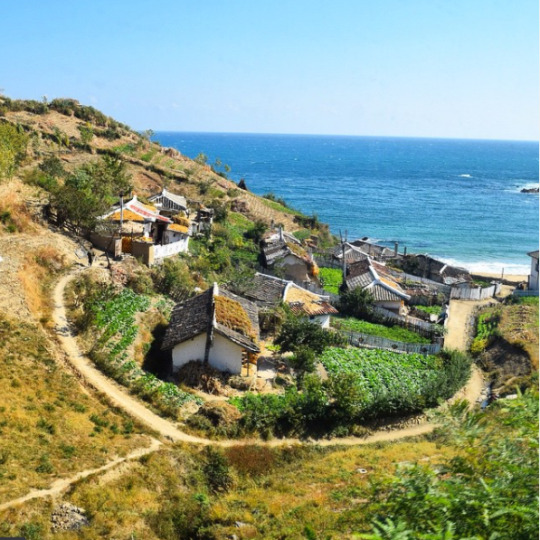
Some typical newly built rural housing, surrounded by farmland.
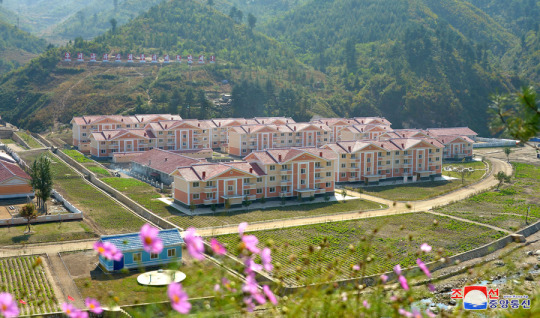
Tumblr only allows 20 pictures per post, but if you want to see more pictures of life outside Pyongyang, check out this imgur album.
#dprk#north korea#i've had this post unfinished in drafts for almost a year#also sorry about the spelling and potential formatting issues it's a nightmare to edit at this point#it was literally just meant to be a collection of picture and then the writing just sort of happened#enjoy the brief heritageposts history lesson i guess
6K notes
·
View notes